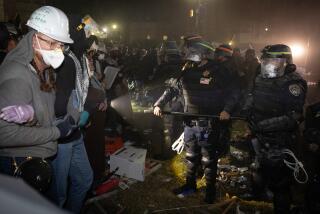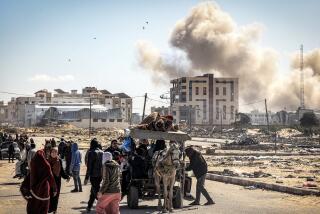The Arabs: Divisions Beyond the Stereotype : America and Arabs: A Shifting View : The Arabs have always been fair game for political cartoonists and moviemakers. But the war is finally forcing a re-examination of long-held stereotypes about the people and the region.
- Share via
DHAHRAN, Saudi Arabia — For as long as there have been movies and popular literature, Arabs have been portrayed in the West as bumbling desert wanderers and wild-eyed fanatics cursed by a love of violence and wealth.
They secured a place in the Western media from which other minorities had long since escaped. They were fair game, the one group that political cartoonists and Hollywood directors could denigrate without fear of reprisal. Even “Sesame Street,” the respected children’s television program, once used an Arab as a symbol of evil.
The stereotyping of Arabs extended far beyond the Middle East to the United States, where the Arab-American community, numbering about 2.5 million people, was often treated with cultural insensitivity and ridicule because of its heritage. An Arab was a millionaire, a terrorist, a camel herder or a refugee but seldom a real human being.
With the United States now fighting Iraq in the Persian Gulf, the Arabs would seem to be increasingly vulnerable to Western scorn and stereotyping. But, in fact, Iraqi President Saddam Hussein may have bequeathed the Arabs in general and the Arab-American community in particular an unexpected gift in this war--the gift of forcing the American public to re-examine longstanding feelings about the Arabs, their role in the Middle East and their identity as a people.
Many Middle East watchers believe this re-evaluation is leading to significant shifts in how the public perceives the region, as well as the Arab-Israeli dispute.
“I sense a significant change, because the American people want to know now who the Arabs really are,” said radio personality Casey Kasem, an Arab-American who opposes the Gulf War. “They’re not interested any more in just the superficial perceptions, including the mythical Hollywood characterization of Arabs. They’re being challenged to rethink the Middle East, whether they’re opposed to, or supportive of, the President.
“Among the majority of Americans, there is a strong sensitivity toward the civilians in Iraq,” Kasem maintained. “It may be the first time in any war that Americans have been concerned about Arabs. But Americans are looking at these Iraqi civilians as real people, just like themselves.”
With the help of the Bush Administration--which has taken great pains to depict just Hussein as the symbol of evil--the Iraqi leader has effectively made himself an aberration. Unlike past Mideast conflicts when the media tended to lump all Arabs together into a monolithic bloc, the Iraqis are now identified as Iraqis, the Saudis as Saudis, the Egyptians as Egyptians.
Some are “good” Arabs because they are on America’s side; some are “bad” Arabs because they are not. No longer is it possible for Americans to view the Middle East as simply two competing forces, with the Israeli allies on one side and the unfathomable Arabs on the other.
For the first time Americans are fighting alongside Arabs in a war supported by the majority of Arab countries. The interests of many Arabs are identical to U.S. interests--both in terms of the military mission and the desire for a postwar realignment that leads to regional stability. To support the presence of U.S. troops here is also to support the efforts of the Saudis, Kuwaitis, Egyptians, Syrians, Bahrainis, Qataris and Moroccans.
And to support these people whose mysterious land is so far from home, one must ask an elementary question seldom raised in the United States: Who are the Arabs?
Television pictures of Arabs in Morocco, Jordan and a few other countries may reinforce old stereotypes. And groups in the United States that track discriminatory trends say the harassment of Arab-Americans--including crank calls to individuals and threats against Arab and Islamic institutions--were running six to eight a month before the war started and have totaled at least 48 since Jan 17. But many Arab-Americans say this harassment, which comes from a radical fringe, does not reflect what they believe to be subtle shifts in public perceptions.
“What I think has happened is that over the weeks and months it took to put the coalition together, there has been a gradual breakdown of one basic stereotype--that the Arab world is a monolithic region, basically anti-Western and hostile to American interests,” said Faris Bouhafa, public affairs director of the Arab-American Institute in Washington.
“Americans, I think, are beginning to understand that the Arab world is a diverse region with diverse interests and diverse leaders and diverse people, only some of which fit the stereotype,” Bouhafa added. “That is one of the positive spinoffs from this war. American interests are the same as Arab interests.
“Most Americans used to think of the Middle East only in terms of what’s good or bad for Israel. They reacted to events as they affected Israel. Now they seem to be asking what’s good or bad for the United States, Saudi Arabia, Kuwait? That’s a big change, and it’s as it should be. All countries, including Israel, should have equal status and equal importance,” Bouhafa said.
“But I’m not going to say we don’t have a long way to go,” he cautioned. “There is no solid understanding of the Arab culture, and even the peace movement has fallen into stereotypes when it rallies in front of the White House with signs that say, ‘Not one drop of blood for Arab oil.’ That slogan is racist.”
There is another element that will affect how Americans perceive Arabs. On Aug. 1, there were no Western journalists and only a few thousand U.S. military advisers in Saudi Arabia. Today there are over 700 journalists and half a million American troops. And in every war, with the possible exception of Vietnam, Americans have come home with a deeper understanding of--and often an admiration for--those with whom they shared the battlefield.
Americans and Saudis have started to get to know each other--not just as princes and generals but as ordinary people. And those new-found perceptions one day will be carried by American sergeants and lieutenants to their homes in Des Moines and Cheyenne and Chattanooga.
To be sure, the relationship has been superficial on most levels. But both sides have come to learn a little something of the other’s culture. U.S. Special Forces teams are assigned to Saudi units to provide command and control. U.S. and Saudi soldiers man roadblocks and checkpoints together. They cross paths in Al Khubar and other shopping districts and often end up in brief conversations, trying to check out each other’s culture. “What they (the Saudi soldiers) always seem fascinated with,” one GI said, “is American women and what they’re like.”
Many U.S. soldiers spent up to 20 classroom hours in Germany and the United States learning about the Arabs and their culture before being sent to Saudi Arabia.
In informal interviews, most expressed interest and curiosity about the people they had come to defend, but virtually none fell back into the pejorative descriptions that were often used to describe non-European allies in other wars. And journalists have devoted almost no energy to writing about the aspects of Saudi society that first-time visitors traditionally love to poke fun at--veiled women, the implementation of the sharia (Islamic law) and stores that close at midday so everyone can pray.
“Actually I haven’t found the Saudis anywhere near as strange as I thought I would,” said a Marine corporal from New Hampshire, offering confirmation of the cracks in one man’s stereotype.
More to Read
Sign up for Essential California
The most important California stories and recommendations in your inbox every morning.
You may occasionally receive promotional content from the Los Angeles Times.










